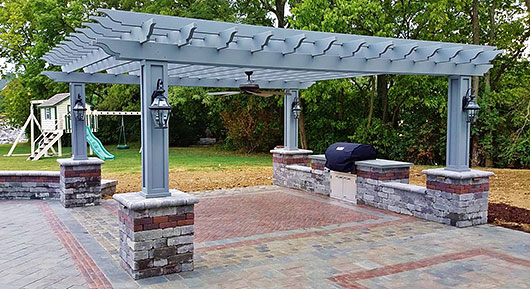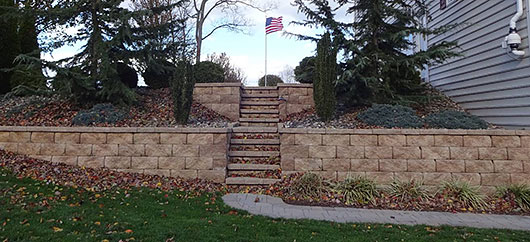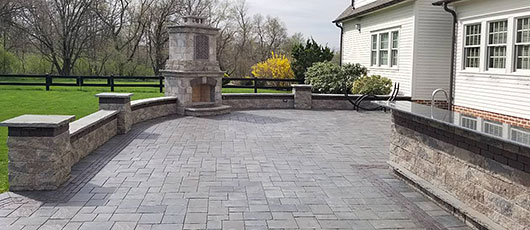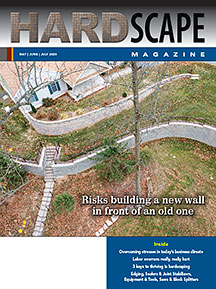Contractor Stories

Still learning after 30+ years
By Tom HatlenAfter 3 decades in business, Burnell Weaver is transitioning out of day-to-day operations, and into full-time managing his company. He will have help. At Weaver’s Landscape Company managing is a shared responsibility. They call his new full-time position “Visionary/Implementer.”
Burnell’s primary responsibilities (with input from others) are: Leadership, Management, Accountability - P&L/Business Plan, R&D/Special Projects - Remove Obstacles/Barriers - Company Vision - Training - Sales/Design Mentor.
Other members of the leadership team include Troy Tyner landscape design and sales and Brady Kuhn hardscape design and sales, Burnell’s former position.
The concepts for the company organizational structure come from a book called Traction by Gino Wickman, and mesh with the need to share responsibilities Burnell learned years ago.
“When we first started out, I wanted to be the one in control and I hardly even wanted my partner’s help. Fortunately I saw the error in that kind of thinking early on. So I've depended a lot on others to help out. I absolutely could not be enjoying the success I'm enjoying today if it wasn't for the help of others.”
Profile
Weavers Landscape Company
Shippensburg, PAFounded 1998
Owners Burnell & Cindy Weaver
Customer base
90% residential10% commercial
Services
50% hardscape & construction35% landscaping & landscape lighting
15% landscape/hardscape maintenance
Project price range
$5,000 to $150,000Annual sales
$1.5 millionEmployees
12-14“Experience has taught me that's not a good way to live.”
Hiring from a tight community
For many years Weaver’s was able to bring on as many quality employees as they needed without really trying. It’s not uncommon for core employees to stay 5 or even 10 years.“We've developed some pretty good craftsmen on our team, and that results in a very nice finished product. We can pretty much do everything, building an outdoor living space from start to finish.”
Burnell says, “We're in a tight church community here where we know a lot of local people. And, so people would either come in and ask for a job, or someone from church would say something.”
If Weaver’s staff didn’t know a person calling in about a job, they would turn the applicant away. “We don’t just open the door and hire warm bodies. We are passionate about the people that work here and the service we provide.”
Hiring crunch hits
Then, at the end of 2021 the company lost 2 people. To replace them, they tried to be more proactive in reaching out to sources of employees from the past. But nothing came of it, and spring was coming on.“It seemed like the well just dried up. And, we had no real process for finding new employees. We had no hiring or onboarding systems. We weren't doing any online advertising or anything like that.
“After listening to some webinars put on by Mark Bradley and LMN (Landscape Management Network), we began to realize that we spent a lot time marketing to get new clients, but nothing on getting employees.”

Setting up a hiring system
They took Mark’s advice to heart and began implementing the steps he suggested to create a system for bringing on new employees.“We spent quite a bit of time developing the careers page on our website. And, we started working with an independent HR person. I didn't even know such people existed. But she's been very helpful. She manages our HR as a subcontractor, and she's helped us post ads.
“Mark Bradley put a lot of emphasis on marketing to employees. ‘Don't just put an ad up that says, “Hey, come do landscaping for $15 an hour,” because you're probably not going to get the kind of people you want. Rather, you want people who care, who can appreciate that you are a company they can feel good about.’”
Burnell says their new hiring program has been a godsend especially since losing 2 additional people in late 2022. “We've hired some new people that we feel are very strong team players. These guys have told their friends. Then they jump on the website and see our careers page. And we finally feel like we now have a kind of filtering mechanism in place where we can advertise to the general public, but we can still be pretty selective about who's going to fit into our culture.”
Probably the most important part of their culture is outlined in their “Core Values” which they make very clear on their career web page and throughout the hiring process.
Burnell says, “We expect a high level of integrity across the board, and we try to make sure our employees exemplify that.”

Continuous improvement
As the new hiring system suggests, Burnell is still very open to implementing new things even after all these years. He says sometimes that can be a problem. “I'd rather spend time learning than working. I like to chase the new stuff and the shiny stuff.”Continually exploring new things has mostly produced positive results and has moved the company forward. “Over the years we probably learned the most about what doesn't work. We’ve had plenty of those experiences. And those are real training events, if you allow them to be.”
Managing client calls & emails
In addition to the new hiring process, Burnell has recently implemented 2 new systems that help him manage incoming calls and emails. “It’s been a game changer for me in managing my schedule.”Burnell says he’s always struggled to keep up with new call-in leads. He would start each season calling everybody back quickly and then fall behind as the season wore on. “It got to the point where I was too embarrassed to even call them back.
“I have a process now that allows me to communicate with anyone that calls in; pretty much within the next day I can get back to everybody.”
When a call comes in, the office manager enters contact information and a brief project description into an electronic form which is then emailed to Burnell. From there, Burnell sends out a welcome email asking for any pertinent photos the prospect can send, and it invites them to schedule a phone call with him thru his Calendly.com web page.
“And so, they select an appointment time on my calendar which is set up to only accept appointments for when I want them. I'd say 90% of prospects do well with the Calendly email setup. A number of them have told me that they like it.
“It has been great. Monday I'll come in and see I have phone calls at 11am, at noon and at one. And I've got an overview of what the people want. They're prepared. I am prepared. And that works out real good.”
Prospects go through Calendly again to schedule a site visit. Relying on the system prevents Burnell from overextending himself with commitments he can’t always keep up with.
Existing clients generally communicate more directly through calls and emails.

Using the Stack Method
Burnell also found it easy to get behind in responding to incoming emails until he discovered an email management concept called the “Stack Method” developed by Prasanth Nair.He says it’s not software, and it’s free. If you’re overwhelmed by volumes of email, he recommends you visit StackMethod.com and watch the video series to learn everything you need to know to implement it.
“Without going on about it here, I’ll just say it has completely changed my viewpoint of email to where it's my best friend. For the last year I have got to where everything's been taken care of and there are no emails in my inbox nearly every day. It’s a good feeling.”













